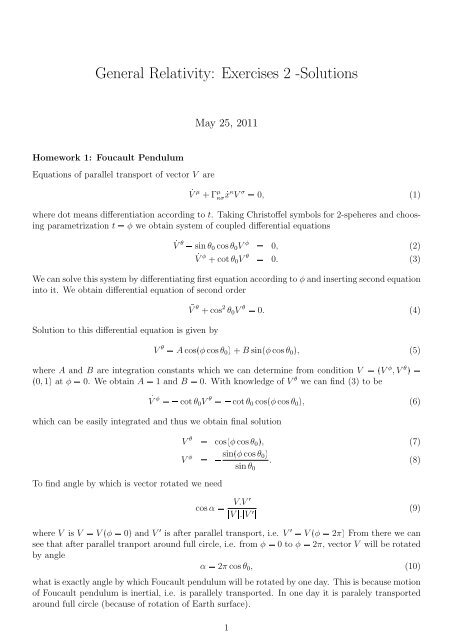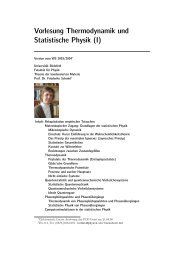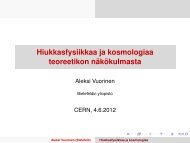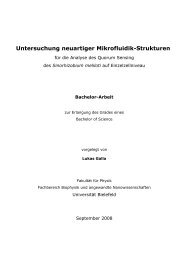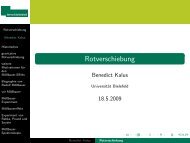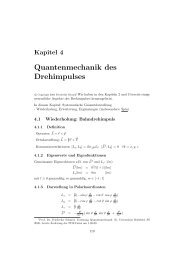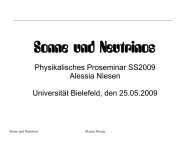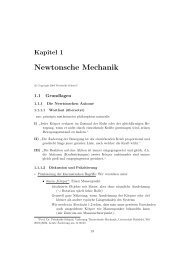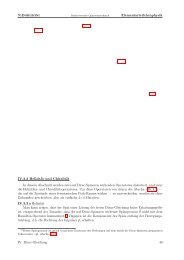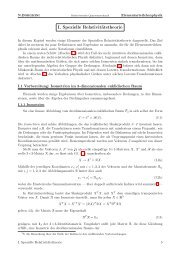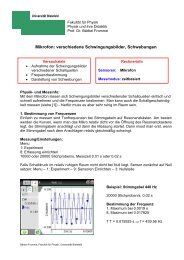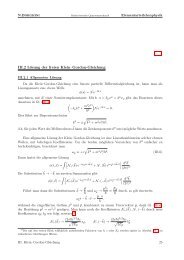General Relativity: Exercises 2 -Solutions
General Relativity: Exercises 2 -Solutions
General Relativity: Exercises 2 -Solutions
You also want an ePaper? Increase the reach of your titles
YUMPU automatically turns print PDFs into web optimized ePapers that Google loves.
<strong>General</strong> <strong>Relativity</strong>: <strong>Exercises</strong> 2 -<strong>Solutions</strong><br />
Homework 1: Foucault Pendulum<br />
Equations of parallel transport of vector V are<br />
May 25, 2011<br />
V µ Γ µ κσ xκ V σ 0, (1)<br />
where dot means differentiation according to t. Taking Christoffel symbols for 2-speheres and choosing<br />
parametrization t φ we obtain system of coupled differential equations<br />
V θ ¡ sin θ0 cos θ0V φ 0, (2)<br />
V φ cot θ0V θ 0. (3)<br />
We can solve this system by differentiating first equation according to φ and inserting second equation<br />
into it. We obtain differential equation of second order<br />
Solution to this differential equation is given by<br />
V θ cos 2 θ0V θ 0. (4)<br />
V θ A cosφ cos θ0 B sinφ cos θ0, (5)<br />
where A and B are integration constants which we can determine from condition V V φ , V θ <br />
0, 1 at φ 0. We obtain A 1 and B 0. With knowledge of V θ we can find (3) to be<br />
V φ ¡ cot θ0V θ ¡ cot θ0 cosφ cos θ0, (6)<br />
which can be easily integrated and thus we obtain final solution<br />
To find angle by which is vector rotated we need<br />
V θ cosφ cos θ0, (7)<br />
V φ <br />
sinφ cos θ0<br />
¡ .<br />
sin θ0<br />
(8)<br />
cos α <br />
V.V <br />
V .V <br />
where V is V V φ 0 and V is after parallel transport, i.e. V V φ 2π From there we can<br />
see that after parallel tranport around full circle, i.e. from φ 0 to φ 2π, vector V will be rotated<br />
by angle<br />
α 2π cos θ0, (10)<br />
what is exactly angle by which Foucault pendulum will be rotated by one day. This is because motion<br />
of Foucault pendulum is inertial, i.e. is parallely transported. In one day it is paralely transported<br />
around full circle (because of rotation of Earth surface).<br />
1<br />
(9)
Homework 2: Twin Paradoxes<br />
a) Call clock at Earth surface Clock 1 and one onboard of satellite Clock 2. For clock on Earth<br />
surface holds<br />
dτ 2 1 dt2 , (11)<br />
For Earth observer Clock 2 are moving so space-time interval which Clock 2 pass (in respect to Earth<br />
observer) is<br />
c 2 dτ 2 2 c2dt 2 ¡ dx 2 1<br />
1 ¡<br />
c2 ¢ 2 ¢ dx 2 2 v<br />
c dt 1 ¡<br />
dt<br />
2<br />
c2 2 2<br />
c dt . (12)<br />
Comparing these two equations we obtain<br />
dτ1 <br />
dτ2 v 1 ¡ 2<br />
¢<br />
1<br />
c 2<br />
v 2<br />
2c2 <br />
dτ2, (13)<br />
after linearization. Orbital velocity velocity can be<br />
<br />
found from<br />
GM v2<br />
GM<br />
v 3, 877 m/s. (14)<br />
r2 r<br />
r<br />
So, difference in flow of proper time for these two obserers is<br />
So, in one day there will be accumulated time difference<br />
∆τ1 1.0000000000835 ∆τ2. (15)<br />
∆τSR ∆τ1 ¡ ∆τ2 7.21 µs. (16)<br />
——————<br />
Note: In order to give rigorous answer to this problem we should count in also motion of observer<br />
1. Observer on Earth surface makes rotation around full circle in 1 day. Highest velocity would be<br />
for observer at Earth Equator, where he would be effectively rotating with velocity of 40, 000 km per<br />
day, i.e. v1 460 m/s, what is about 10% of orbital velocity of satellite. Relation for dilatation of<br />
time is quadratic in velocity, so counting in this rotation of observer on Earth surface would cause<br />
correction about 1%, what is effect which we can neglect.<br />
——————<br />
b) Similar effect works in GR,only here it is caused by gravitational field. From lecture on Newtonian<br />
limit You know that<br />
g00 ¡1 ¡ 2φ<br />
. (17)<br />
c2 Denote g001 to be metric coefficients at the place of observer on Earth, i.e.<br />
Then proper time at the place of Clock 1 will be<br />
and at Clock 2<br />
From where we obtain relation between proper times<br />
g001 ¡1 ¡ 2φ1<br />
. (18)<br />
c2 dτ 2 1 g001dt 2 , (19)<br />
dτ 2 2 g002dt 2 . (20)<br />
dτ1 <br />
g001<br />
g002 dτ2, (21)<br />
2
which after linearization<br />
<br />
of square roots is up to order Oφ<br />
1<br />
dτ1 1<br />
c2 φ1 ¡ φ2 Oφ 2 GNM<br />
dτ2 1 ¡<br />
c2 ¢ 1<br />
r1<br />
¡ 1<br />
dτ2, (22)<br />
where r1 is distance of observer 1 to center of Earth and r2 distance of observer 2. Numerically<br />
Their difference accumulated during one day is<br />
∆τ1 0.99999999894∆τ2. (23)<br />
∆τGR ∆τ1 ¡ ∆τ2 ¡45.737 µs. (24)<br />
c) You can see that total accumulated time difference due to GR and SR in one day will be<br />
∆τ ∆τGR ∆τSR ¡38.527 µs. (25)<br />
Interesting thing is that these two effect of dilation of time in some sense acts in ”opposite ways”, i.e.<br />
SR time-dilation cause satellite clock ticking slower than those on Earth surface and GR time-dilation<br />
cause satellite clock tick faster.<br />
3<br />
r2


